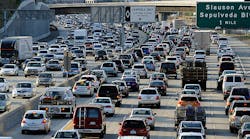Every year the American Transportation Research Institute (ATRI) releases a study on traffic congestion on the nation’s highways. The most recent Cost of Congestion to the Trucking Industry report, found that congestion in 2016 added $74.5 billion to the trucking industry’s operational cost, a 0.5% increase from 2015 figures.
In addition to adding cost, these delays added about 1.2 billion hours in lost productivity. As ATRI explains, it that is the equivalent to 425,533 truck drivers sitting idle for an entire year. On a per truck basis, congestion is costing $6,478 a year.
It should come as no surprise that congestion is worse in urban areas — 91% of total congestion costs occurred in metropolitan areas. And with the growth of e-commerce and next- or same-day delivery, that congestion is likely to get worse, not better. Known as the “Amazon Effect,” we are seeing people bypassing retail outlets and purchasing online instead. While this creates additional transportation opportunities it undoubtedly adds to congestion especially when you consider that somewhere between 30% and 40% of goods ordered online are returned.
Any way you look at it, we’re wasting a lot of money and time because trucks are sitting in traffic. What these figures tell me is that route optimization is more important than ever.
All too often a fleet has drivers continually using routes that were set up years ago. This is one of those cases where everyone thinks everything is working properly so why mess with it. The reality is that if you are not periodically reviewing your routing decisions, you likely are not operating as efficiently as you could be. You may have made an acquisition or merged with another entity requiring more or different products being put on different routes. You may have added or lost customers. Customers may have changed their buying habits, which could allow for different delivery days, etc. All of these and others not mentioned have impacted your product distribution. These need to be factored into your route optimization decisions.
Optimizing your routes is a good business practice, but the situation with congestion is not going to get significantly better until we do something about the state of the nation’s infrastructure. Each of us needs to speak to our legislators to make sure they understand what congestion is costing the trucking industry and by association business, industry and even consumers. Urge them to allocate funds to deal with some of the worst bottlenecks at the very least, but preferably to address the overall crumbling infrastructure across the country.
Until that happens, it will be up to each fleet to see that they are routing trucks in the most efficient manner to avoid as much congestion as they can and to ensure each truck is as productive as possible.



